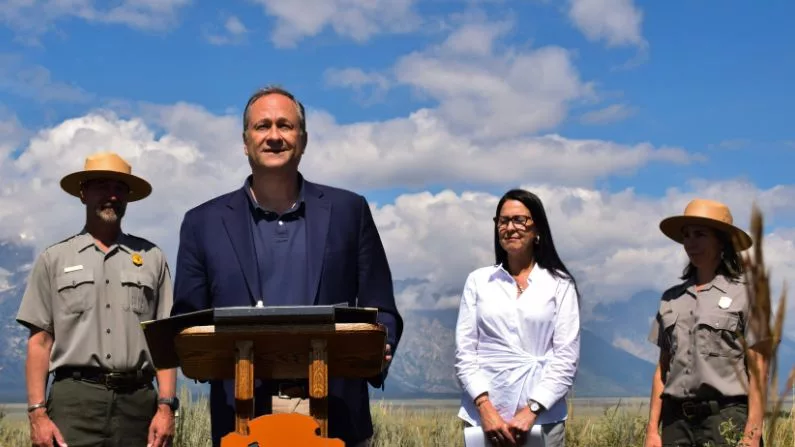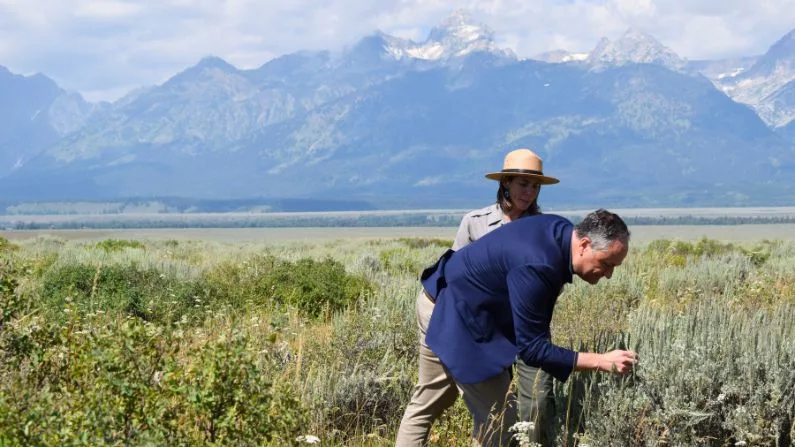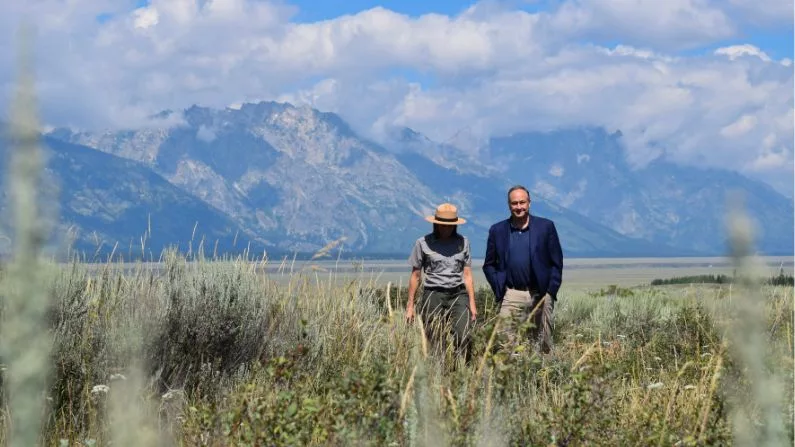Second Gentleman Douglas Emhoff walked alongside wide-brimmed-hat-wearing park staff in the summer sun through a sea of sagebrush on Wednesday.
The husband of Vice President Kamala Harris was in Grand Teton National Park to help announce a $44 million investment in making national parks more resilient to climate change.
“All Americans love our national parks, this American included,” Emhoff said, as the Tetons stood tall in the background. “Preserving this land matters. It matters to all of us. It matters to everyone.”

Emhoff announces the new federal climate investments to a small crowd of press in Grand Teton National Park. (Hanna Merzbach/KHOL)
The funding to preserve land and water in national parks comes from the Biden Administration’s Inflation Reduction Act, which passed last year.
Emhoff’s visit came a day after President Joe Biden created a new national monument near the Grand Canyon.
Restoring sagebrush ecosystems
Following this week’s announcement, Yellowstone National Park announced it and Grand Teton National Park will get an infusion of $712,655 in federal funds for restoring natural habitats and addressing climate change impacts.
Emhoff said a large part of the funding will go towards sagebrush projects.
“Restoring sagebrush helps us build healthy ecosystems, which support access to water, local communities and economies,” he told the crowd.

Jones shows Emhoff a healthy sagebrush habitat, with a diversity of plants, in the national park off Mormon Row. (Hanna Merzbach/KHOL)
In the Tetons, the vast sagebrush landscapes are a critical habitat for mule deer, elk and pronghorn, which all funnel through during their regular migrations. Even grizzlies rely on sagebrush, digging up the plants and eating their roots.
A 2022 report showed Wyoming has the largest intact sagebrush ecosystem in the West, but it used to be even bigger.
Homesteaders removed a lot of the shrubs in the region in the 1800s, but park staff are restoring them, and the federal funds will accelerate that work.
Park ecologist Laura Jones, who’s leading those projects, said the money will help the park generate more native seeds and hire more people to plant them.
“By doing this, we are not just restoring the plant community and the wildlife that depend on it,” Jones said. “We are making this core sagebrush habitat area more resilient in the face of climate change.”
‘We must act now’
The Biden Administration’s America the Beautiful initiative has a goal of preserving 30% of U.S lands and water by the end of the decade.
Funds in the region will also go toward restoring Grand Teton and Yellowstone whitebark pines, which help keep snow on the ground and reduce erosion. The U.S. Fish and Wildlife Service recently listed the high-alpine trees as threatened under the Endangered Species Act.
Emhoff said, federal dollars will also help make national park water supplies less vulnerable amid a changing climate.
“There is a climate crisis happening right now everywhere as we speak — there’s no disputing it. There’s no denying it,” Emhoff said in his closing remarks. “We must act now before it’s too late.”





